“It’s — Mars. Only, the way it must have been. A city, the city around this building. Roads. Machines that move, and a horizon full of man-made buildings? Perhaps they’re buildings. The picture moves — and the streets are full of creatures, like the statues. No, they’re different. Some hurry,… some go slowly …. this whole plateau, all of High Weir must have been some incredible acropolis for a mammoth, cosmopolitan community! … Through his faceplate he could almost see the great city of High Weir stretching away to the temple. But slightly out of focus, indistinct… How was he supposed to know which were shapes of time-cast dust and which were the intelligent creations of the amazing culture of his people, his planet? … He walked down the blazing, alien street. … I’m a Martian, I’m a Martian — … Rimkin looked out over beautiful rifts and dells, shapes that could have been sand dunes, that could have been the amazing structures of the great Martian city of High Weir, that could have been… He was crying again. ‘It hurts so much,’ he said quietly, ‘how am I supposed to tell?’
— High Weir, Samuel R. Delany, 1968
Ah, Mars.
The almost-Earth.
Some call it.
So close and yet so far.
A projection screen for our multiform fantasies, a glitchy transmission, scrambled channels, a pregnant wasteland of the imagination?

Princesses, canals, invaders, Faces, pyramids, dead civilizations, ET ecosystems, the Ninth Ray … what science fiction writer hasn’t written a story based on Mars?
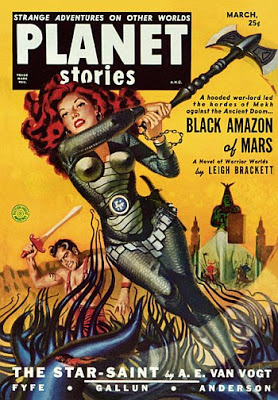
Matt Damon growing potatoes, please. So banal!
We’d take a nuke attack over that narrative.
(But to be honest, this writer had two dreams of Mars: in the first, a kale farm in the open Mars air, next to a Coca Cola-branded terraforming container. In the second, some cool subcultural shops and shenanigans in a domed Martian entertainment complex, with Bjork somewhere in the mix. But in general, yes, who other than mega-geeks, xenobiologists or loonies spend anytime wondering about “Life on Mars.” Why are you even bothering to read this?)
And now, for us curious consumers of NASA / JPL imagery, a dry, barren shattered world, fit only for wanderings of robo-rovers. Someday a science outpost, maybe.
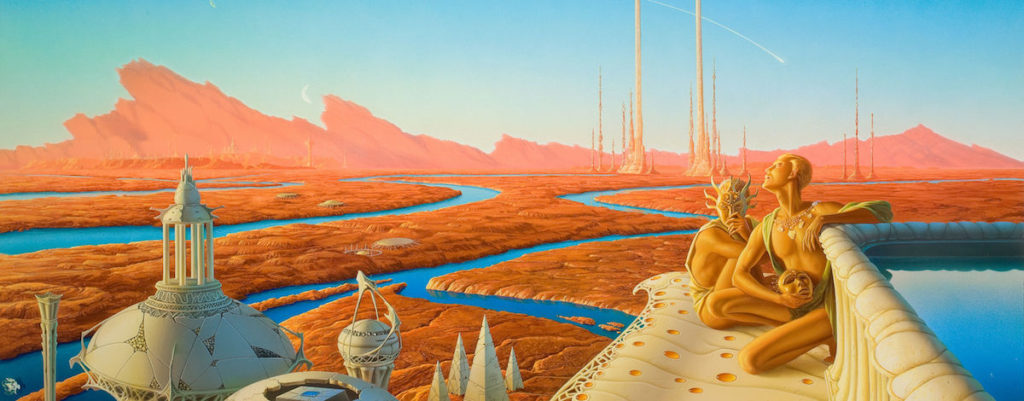
Just to clear, you will find no ‘Answers’ here, just a few hunches amid speculation, confabulation and probable propaganda.
Why should we know what is ‘realistic’ on an alien world?
Le Mars Imaginaire.
No, wait.
Something else is going on. We live in a sea of lies. Someone is hiding things from us. We just don’t know what, exactly.
Mars. Antarctica. Egypt. The origins of WWII. History as a pile of halftruths, “written by the winners”. The 20th century we think we know is an architecture built on secrets stacked on secrets.
So we spin tales, we see patterns in the noise, faces and canals and critters in the rubbly, sandy chaos of martian ‘regolith’.
And maybe we are spun, by NASA and whatever / whoever it was that operated secretly prior to the official inauguration of Trump’s Space Force. Breakaway Civilization, anyone?
In the new NatGeo Mars series, ‘Marstronauts’ discover a single-celled organism at the bottom of a bore-hole. Of course they fall ill from the local pathogen. Then get cured. Not very sexy. Boring “Hard science fiction” extrapolation.
It’s almost consensus now that Mars was ONCE UPON A TIME capable of supporting life. And that some hardy lifeform may still eke out an existence, most likely underground – the Martian Underground, eh wot? — in the form of lichens, fungi, slime-molds, extremophiles gnawing on rock, salty water, and electrons…? There was that meteorite that supposedly came from Mars, that supposedly contained microbial fossils…
But nobody has set foot on Mars yet to prove or disprove it — have they?
Again, exactly how do they have enough data to know just how long ago Mars had oceans and rivers? Was it hundreds millions of years, or a few thousand, or only decades?
When media and NASA say “capable of supporting life”, it can feel like …they are preparing us for some future news, info that Somebody already knows.
Greg Bear’s Moving Mars describes a bygone Martian ecosystem, of an organism-as-an-ecosystem, that ought to be real. More of that below.
Most recently, Dr. William Romoser, a ‘bug boffin’ & Professor Emeritus from Ohio State University, incited a ruckus by inferring many insectoids from NASA photos. Via lecture, not yet a published paper. Massively disputed by colleagues, of course — just another case of “pareidolia” — seeing faces in clouds. Somebody was embarrassed. The press story from OSU vanished the next day. Just to be clear, this guy is not just just a youtuber fanatic, he’s a credentialed entomologist.


Bugs on Mars, not very sexy.
Preceding that news, we have seen an on-again, off-again series of announcements, retractions, claims, debunkings… going back to the early 70s Viking experiment, deemed to show a negative result by NASA authorities. Yet the device’s designers to this day maintain it showed a positive result. Recent anomalous methane and oxygen spikes seem to support their claim, but could be due to geological factors.
It is starting to seem like there may be liquid water on Mars in places, at certain times, in some forms. Check out this suggestive photo from orbit:
Thing is, Mars has seasons different from our own. It has a more oblique orbit and a different tilt, so would get warmer on average as it closes in to the Sun, nights not quite as sub-freezing. Warming could melt frozen water under the regolith, gases could be released. If lifeforms exist on Mars they could be adapted for long periods of dormancy, and pop up when conditions are less harsh. Also temperatures at the bottom of Vallee Marineris can, theoretically, reach into the 70s, briefly, and the air pressure is higher there too. Still no oxygen in the atmosphere, assuming all the readings are correct and not edited, but that may not be such a problem for photosynthesizers, CO2=Plant Food, as the saying goes. Microbes have other, highly creative metabolisms, as extremophiles here in Earth demonstrate.
But lacking oceans, at the moment, Mars doesn’t have a way to store solar energy and buffer wild day-to-night temperature swings, as the oceans do for us over here on Terra. (Liquid water and water vapor btw are the primary regulators of climate here on Earth, controlling roughly 90-95% of temperature swings; CO2 is at best a tweak on the underlying ‘volume control’, and mainly works by ratcheting up slightly the amount of water vapor in the air, its ability to store a tad more heat energy. So the standard argument goes.)
There seemed to be a “perchlorate” aka salty version of liquid water in hillside seeps, with a lower freezing point because of the dissolved minerals. Highly undrinkable. Nasty stuff. But even that very conservative claim, identifying dozens of seep sites or cliffs with clear runoff patterns, was later attacked.
& now there’s a study on the viability of microbial life in such especially brackish H2O.
Then there are the “blueberries,” bazillions of tiny spherical pebbly thingies, strewn across some regions. Many conflicting interpretations. Yeah, blueberries. Maybe produced by … lightning?
Water ice “definitely” exists at the poles, and in some craters. Again, they say. But it’s empirically detectable in a bunch of satellite photos and radar readings.
For some time we were glued to Joseph Skipper‘s MarsAnomalyResearch.com site, especially the “Banyan Tree-like formations” – later debunked by NASA, of course, as “frozen methane seeps,” … Skipper was convinced that large singular, plant-like organisms covered vast areas of martian terrain. As below:
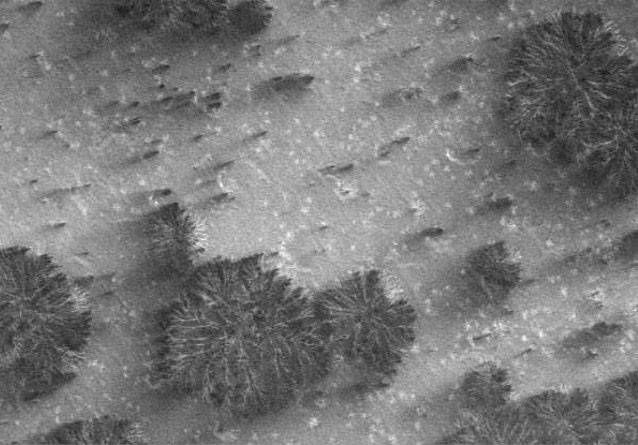
For a spell, Hoagland’s Face on Mars narrative was intriguing — wouldn’t it be cool if — but somehow never entirely convincing. Like he and his compadres had to work way too hard to demonstrate it, even against, again, a later set of higher resolution images that seemingly reduced it all to a “litterbox” of randomness. The face dissolved but still left oddly parallel and perpendicular lines… their “D&M City geometries” as well. “BUT BUT BUT They are covering it all up!!!!” … (ensuring web traffic for Hoagland, at any rate.) Well, who really checked Hoagland’s fancy math and reasonings as to what was artificial vs. natural, all on an alien planet, at that. Some bright folk like Joseph Farrell, bought some % of Hoagland’s story, FWIW.
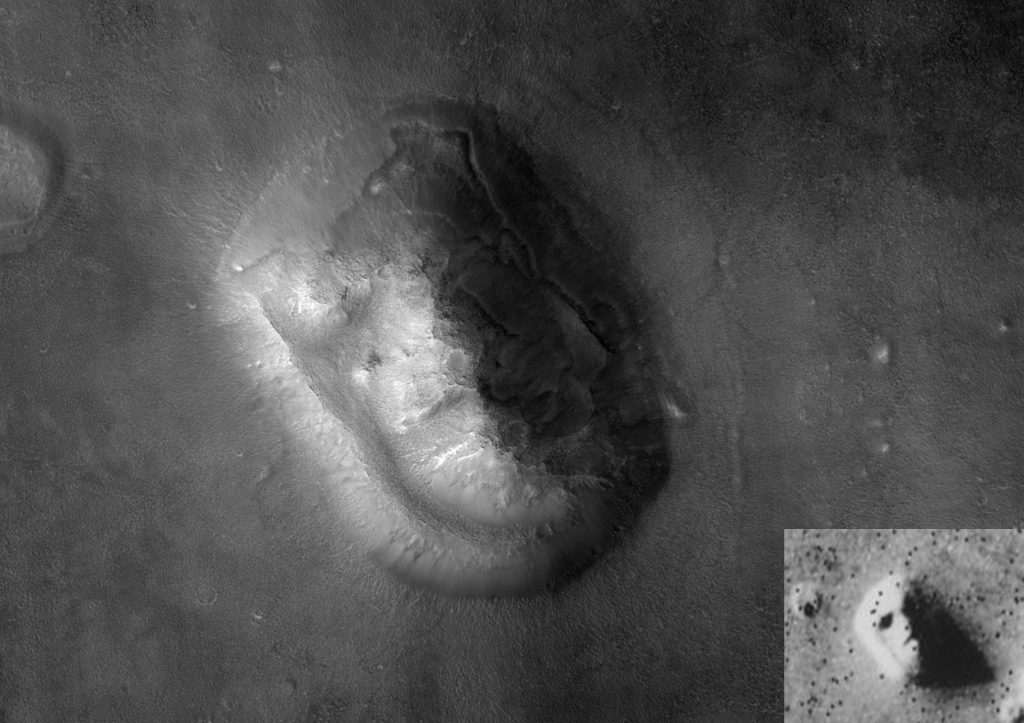
And then there were the “Glass Tubes”, with irregular but periodic arch-like structures. This obscure post imaginatively argued that the tubes or tunnels are the exoskeleton of a very large blimp-like organism. No, just a sand dune effect, per NASA. Others suggest they are ancient aqueducts, contain dolphin iconography, or… are simply “sand dune chains,” per NASA’s usual bland dismissal. Just FYI additional photo passes were years later released at a 30% lower resolution, showing the anomalous “dunes” in the exact same position. Also nearby are a set of craters that appear to have convex domes.

This inability to look beyond orthodox science conclusions reminds of the ‘SEP field’ that hides an alien spaceship from human eyes in Douglas Adams’ novel Life, the Universe, and Everything (part of The Hitchhiker’s Guide to the Galaxy series). ‘SEP field’ stands for “Somebody Else’s Problem field” – the spaceship is made invisible by the brain’s desire not to see it:
An SEP is something we can’t see, or don’t see, or our brain doesn’t let us see, because we think that it’s somebody else’s problem. That’s what SEP means. Somebody Else’s Problem. The brain just edits it out, it’s like a blind spot… The Somebody Else’s Problem field… relies on people’s natural predisposition not to see anything they don’t want to, weren’t expecting, or can’t explain
Currently, in the lineage of Skipper and Hoagland, cheesy and cheap social feeds spew daily Mars anomalies, each conveniently named in advance (“shopping cart,” “lizard,” “motor,” “cat,” etc) and colorized to foreground the alleged humanoid or sculpture or critter in question from the surrounding rubble. Dozens of #MarsAnomalies YouTube channels too, all equally unconvincing of technological artifacts, but sometimes intriguing.
But, doesn’t Mars, from what we can plainly observe, seem to be a DESTROYED / shattered landscape? It’s an impression, a non-scientific impression, ok, even if you don’t accept all the cheap so-called anomalies. Like a form of propaganda, highlighting the figure seems to normalize the ground.
MAYBE some of the weirdly shaped, evocative rubble is residue of a bygone technical culture, maybe. There are moments when one gets that impression. (And who knows, had an earlier human civilization made it over there?) It’s fun to think so, anyways, at least briefly. Suspension of disbelief, as with as any sf novel.
Such an impression could veer for external support to the Plasma Cosmology / Electric Universe crowd, who suggest Vallee Marineris is not the result of erosion but of titanic interplanetary lightning bolts carving out the surface, and/or to Tom Van Flandern‘s Exploded Planet Hypothesis. No ETs required, but optional.
Is there still “somebody” living underground there? Are the lava tubes already inhabited? Are they related to us?
In Heinlein’s Stranger in a Strange Land, a human is brought back from his native Mars tribe, and proceeds to propagate the Martian religion of grokking and orgies and water worship.
Samuel Delany’s High Weir is a great melancholic Mars story (Driftglass anthology, an absolute must-read to hear the 60s echoed through science fiction), in which a lone astronaut communes with a bygone Martian culture thru holographic records stored in the eyes of sculptures.
Kim Stanley Robinson‘s Red / Green / Blue Mars trilogy — maybe the definitive work of the genre — contains zero indigenous Martian lifeforms. Only a folkoric hallucination by the arriviste Terrans. Hard sci-fi, no ETs. KSR’s Mars is a blank slate, just geology. No biosphere. No contamination to worry about, in either direction. But humans evolve new cultures on Mars. And they push the envelope on synthetic biology, designing eco-systems from the bottom up. Maybe elsewhere we’ll excerpt some of the passages around his eco-prophetess bioengineer character Hiroko Ai, proponent of Aereology and life viriditas.
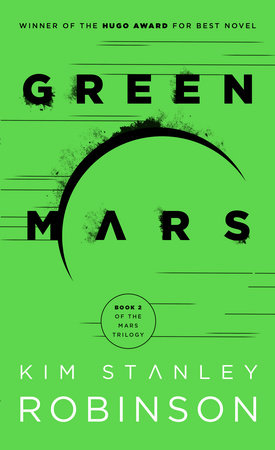
A lovely archetype for an emergent culture. For Mars Geeks, anyway.
But while we’re still on an areological ramble, let’s hop back to Greg Bear’s version of Le Mars Imaginaire:
“Round, cubic, pyramidal, elongated, every shape imaginable, surrounded by feathery filters, long stalks terminating in slender, gnarled roots; the ancient Glass Sea creatures appeared like illustrations in an old book, glittering rainbows of diffraction as the torch moved. I specked them waving in soup-thick seas, sieving and eating their smaller cousins. “Sometimes they’d lift from their stalks and float free,” …the first examples of a Foster co-genotypic bauplan,” …no speciation, all working from a common blueprint, making a few hundred different forms. All one creature, really. … I knew a little about the Mother-Cysts — single-organism repositories of the post-Tharsis Omega Ecos, a world’s life in a patient nutshell, parents of the acqueduct bridges… buried in the sands, awaiting for one of the ancient wet cycles to come around again…. the last of their kind.”
Lastly — is there any lastly, when it comes to Mars imaginings? — in Gurdjieff’s epic opus tome to end all esoteric tomes, All & Everything, the tribe of wiser beings comes to Earth from … you guessed it…

Or maybe Mars is just another deflection from where the real action is, on cloud-wrapped Venus?
— Rydra Wong
Other random links to round out the ramble:
Crappy video on secret colony on mars
Amphipod from deep under Ross shelf ice in Antarctica — just another example of critters thriving in extreme condition
PK Dick Mars adaptation in Total Recall
Million miles?’
Lastly, Bowie’s Spiders from Mars

Clearly this post is not yet fully cooked…



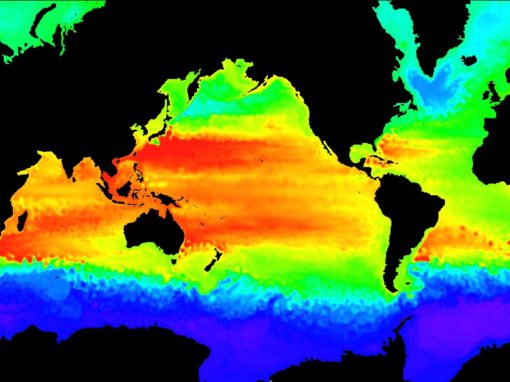

Michael
2021, February at 12:38 pm
Where life is & minimum necessary for it is the Whole Earth System https://books.google.com/books/about/Gaian_Systems.html?id=mHf8DwAAQBAJ&printsec=frontcover&source=kp_read_button&newbks=1&newbks_redir=0&gboemv=1